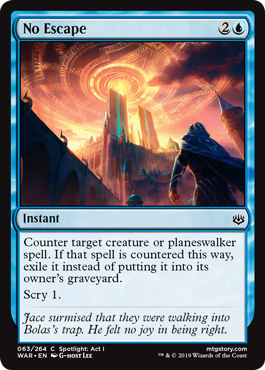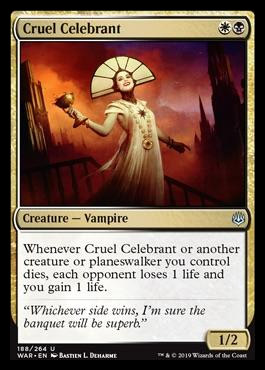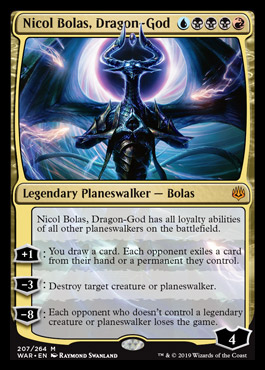BUILDING FOR WAR
The climactic battle is upon us in War of the Spark – take on a Two-Headed Giant prerelease with a teammate to topple even the mightiest foes! Combine your sealed pool with a friend’s and build the best two decks. With more cards to use, Two-Headed Giant decks will generally be stronger than their single-pool counterparts, so craft yours accordingly. Here are a few tips to help guide you toward this format’s HIDDEN GEMS.
 Evasion: With more creatures in play, board stalls can happen very quickly. Evasive creatures are critical! Flying is especially relevant both on offense and defense. Keep an eye out for creatures in the set that can’t be blocked like Ashiok’s Skulker. On the other hand, creatures with menace like Iron Bully tend to be much worse with twice as many potential blockers. This is doubly true in a set like War of the Spark that is full of planeswalkers – it’s critical to be able to keep opposing ‘walkers at bay.
Evasion: With more creatures in play, board stalls can happen very quickly. Evasive creatures are critical! Flying is especially relevant both on offense and defense. Keep an eye out for creatures in the set that can’t be blocked like Ashiok’s Skulker. On the other hand, creatures with menace like Iron Bully tend to be much worse with twice as many potential blockers. This is doubly true in a set like War of the Spark that is full of planeswalkers – it’s critical to be able to keep opposing ‘walkers at bay.- Countermagic: With stronger decks there are more must-answer bombs overall and the risk of devoting a turn to counter an enemy spell (say, with Crush Dissent) is less problematic when your teammate helps advance the board. Your situational counterspells like Dovin’s Veto and No Escape will find their targets more often, but be aware that there are no unconditional counters in this set!
- Situational Answers: Cards that only interact with specific card or creature types are normally relegated to the sideboard but with two opponents they’re more likely to have a target. Remember that matches just one game – you won’t have a chance to grab a silver bullet after seeing what you’re facing! Look for versatile cards that answer multiple threat types like Angrath’s Rampage, Return to Nature, Topple the Statue or, if you’re lucky, Casualties of War.
- Quick Tips
- Play or draw: In 2HG sealed it’s often correct to choose to draw if your decks aren’t incredibly aggressive. Drawing two extra cards on your first turn can be a significant advantage if you’re planning for a longer game.
- Mulligan: Each player has one ‘free’ mulligan. Use it aggressively! If you have a sub-par hand, pitch it back and try again. It’s not worth risking a mediocre opening seven.
Some notes specific to War of the Spark
- “You” means You!: Watch out for the sneaky text “you” or “your” – a large number of cards in War of the Spark only impact your own board. It may seem subtle, but we don’t want you to try to send your teammate’s creature on a Stealth Mission and realize too late that you can’t. Additionally, many planeswalkers only impact your own creatures with their abilities.
- Planeswalkers – With a planeswalker in every pack (plus the promo you get for a Prerelease), there will be a lot of planeswalkers around. When you declare attackers, you must declare whether you’re attacking a player or one of the ‘walkers they control*. There will be many more options than usual so make sure you communicate clearly to avoid confusion.
- Proliferate – This ability allows you to choose any number of permanents with counters on them to add counters to, including ones you don’t control. This is great for building your board and helping your teammate at the same time. Cards like Evolution Sage, Flux Channeler, Grateful Apparition and Merfolk Skydiver that can continually increase your board presence are quite valuable and can generate a lot of value over a short time.
- Board Wipes: Massacre Girl, Ravnica at War, Solar Blaze, Time Wipe and Widespread Brutality all have the potential to clear the board. These can be used to great effect as a team, allowing your enemy to overcommit then clearing the way so that you can build up stronger.
BETTER TOGETHER
As we mentioned earlier, 2HG matches are best of one. You want as many of your cards as possible to be efficient and flexible. That means looking for cards that answer varied threats or that can benefit you and your teammate.
- Utility: Some cards gain additional benefits from being versatile. When evaluating cards, note which ones can interact with your teammate.
 Courage in Crisis – Put the +1/+1 counter wherever you’d like, then proliferate to increase value for the whole team.
Courage in Crisis – Put the +1/+1 counter wherever you’d like, then proliferate to increase value for the whole team.- Jiang Yanggu, Wildcrafter – The static ability only benefits your creatures but the activated ability can put a counter on your teammate’s creatures as well.
- Kiora, Behemoth Beckoner – Untap your teammate’s lands to accelerate even more quickly, perhaps one enchanted by…
- New Horizons – Enchant your teammate’s land to help fix and ramp their mana!
- Pollenbright Druid – Put a +1/+1 counter wherever it’s needed most or build up the whole team.
- Samut, Tyrant Smasher – Since Samut grants your own creatures haste, why not use her loyalty ability to share haste with your teammate?
- Trusted Pegasus – Send your teammate’s attacking creature to the air as well.
- Combat Tricks: Instant-speed spells that don’t specify creatures “you control” can be great at fouling up combat math for the opponent. Watch for (and watch out for) common and uncommon tricks like Battlefield Promotion, Defiant Strike, Giant Growth, Nahiri’s Stoneblades, Samut’s Sprint, Steady Aim or Unlikely Aid.
Some cards benefit from the Two-Headed Giant format either through additional life, more creatures or simply more options. Here are some notable cards to be aware of:
 Bolas’s Citadel – Having a higher starting life total gives you more resources for casting spells from the top of your library. Additionally, the slower pace of most 2HG games will make the activation of the final ability much more realistic – and that one causes your opponents to lose 20 total life!
Bolas’s Citadel – Having a higher starting life total gives you more resources for casting spells from the top of your library. Additionally, the slower pace of most 2HG games will make the activation of the final ability much more realistic – and that one causes your opponents to lose 20 total life!- Command the Dreadhorde – More graveyards means more options and you get to use your higher starting life total with greater discretion.
- Chainwhip Cyclops – With many games trending toward stalls and evasion, having a way to clear out pesky blockers can be quite valuable.
- Makeshift Battalion – Finding two other attacking creatures is much easier with a partner! This can pick up counters by attacking and get boosted by a teammate’s proliferation.
- Mayhem Devil – With more targets and twice as many players sacrificing permanents, this card gains a lot of potential value.
- The Elderspell – More planeswalkers means more power to siphon for a planeswalker of your own! Wait… isn’t that the plot of the set?
- Vraska’s Finisher – With more creatures and spells dealing damage, this is much more likely to finish off a creature or planeswalker.
“EACH”
The word “each” gains a great deal of power in multiplayer formats. Here are some of the cards that impact each opponent, often doubling their effectiveness:
- Bond of Discipline – While not specifically ‘each,’ this card will essentially break every board stall, likely winning the game in the process. While only your creatures gain lifelink, it likely won’t matter – this is a Two-Headed Giant bomb!
- Cruel Celebrant – While it only triggers for creatures and planeswalkers you control dying, causing your opponents to lose 2 total life and picking up 1 life yourself each time can be backbreaking over a longer game.
- God-Pharaoh’s Statue – Taxing both opponents and netting 2 life lost each turn is really good. You’ll be happy with this card on board.
- Liliana’s Triumph – Sacrifice effects aren’t as good as targeted removal but this card is a two-for-one, potentially a four-for-one! Know that its value diminishes as the board fills up but this has its moments of being quite oppressive.
- Turret Ogre – If you can reliably trigger its ability, 4 damage to the opponent when it enters play can really add up. Reach is also a helpful add-on.
- Vampire Opportunist – The 7-mana activated ability seems daunting, but it means a 6-life swing each time you can activate it since each opponent loses 2 life. Think of this ability as a late-game safety valve and a mana sink when the board gets stalled.
PLANESWALKERS
In a set with so many Planeswalkers, it’s worth listing some of them separately. These effects impact all of your opponents in some way.
- Ashiok, Dream Render –
 Ashiok’s -1 ability exiles each opponent’s graveyard regardless of who you target. Keeping both opponents from searching their library is also quite helpful. If you’re able to activate Ashiok’s ability all five times you’ll have cleared twenty cards from the opponent’s library – a terrifying feat!
Ashiok’s -1 ability exiles each opponent’s graveyard regardless of who you target. Keeping both opponents from searching their library is also quite helpful. If you’re able to activate Ashiok’s ability all five times you’ll have cleared twenty cards from the opponent’s library – a terrifying feat! - Davriel, Rogue Shadowmage – While this triggers for each opponent, you’re likely to only gain value on one at a time. Persistent damage is always useful and this card threatens that nicely.
- Dovin, Hand of Control – Taxing your foes and neutralizing a threat is helpful when you’re building up a boardstate.
- Karn, the Great Creator – Shutting down your opponent’s copies of some of the nine artifacts with activated abilities in this set isn’t particularly relevant in most games. The -2 sideboard tutor could be, but in most cases this is likely best left out of your deck.
- Narset, Parter of Veils – While limiting opposing card draw can be helpful, I wouldn’t recommend including this card in your deck unless you can cosistently benefit from her -2 ability.
- Nicol Bolas, Dragon-God – I don’t think I need to convince you that this card is great! Even though each opponent gets to choose whether they exile a permanent or a card from hand with his +1 ability, the value is quite high. And, if you get to his ultimate ability, it checks each opponent to see if they lose the game. It only takes one ‘head’ to lose for the whole team to lose!
- Ob Nixilis, the Hate-Twisted – “An opponent” includes both opposing heads, yeilding 2 damage per turn. This also gains the flexibility of turning your team’s less useful creatures into card advantage. The versatility is quite valuable.
- Teferi, Time Raveler – Locking your opponents out of instant-speed gameplay allows your team a lot of breathing room. You can enter combat confidently and you can cast spells without fear of countermagic.
- Tibalt, Rakish Instigator – While keeping the opposing team from gaining life can be useful, in a one-game match you can probably find better inclusions than our devilish friend.
HIDDEN DUDS
These are the cards that suffer the most from the multiplayer format. While you may find exceptions that make them work for you, be aware that they are inconvenient at best and disastrous for you in most other cases.
- Ajani’s Pridemate – Without any reliable, repeatable life gain options outside of Ajani, the Greathearted, this card fails to make the cut. Your teammate can’t help either since you have to be the player gaining life**. Barring unusual circumstances this won’t be worth your trouble.
- Silent Submersible – This vehicle has no evasion and costs at least one creature to crew. It has a high setup cost and is unlikely to push through damage in clogged boardstates.
TOP 10
These are the cards I feel get the biggest boost from being in a multiplayer environment, not necessarily my top picks overall. You should still prioritize solid removal and efficient creatures but I personally value these cards and others like them highly.
Top 5 Common/Uncommon picks:
Top 5 Rare/Mythic Rare picks:
You’ve reached the end of another war! Was this helpful? Did I miss any cards you thought should be mentioned? Did you take down your own 2HG prerelease? Let me know in the comments and may good fortune follow you until we meet next spoiler season!
Kade Goforth is a Level 2 Judge from Oklahoma.
* CR 802.3 – As the attacking player declares each attacking creature, he or she chooses a defending player or a planeswalker controlled by a defending player for it to attack.
** CR 810.9 – Damage, loss of life, and gaining life happen to each player individually. The result is applied to the team’s shared life total.
